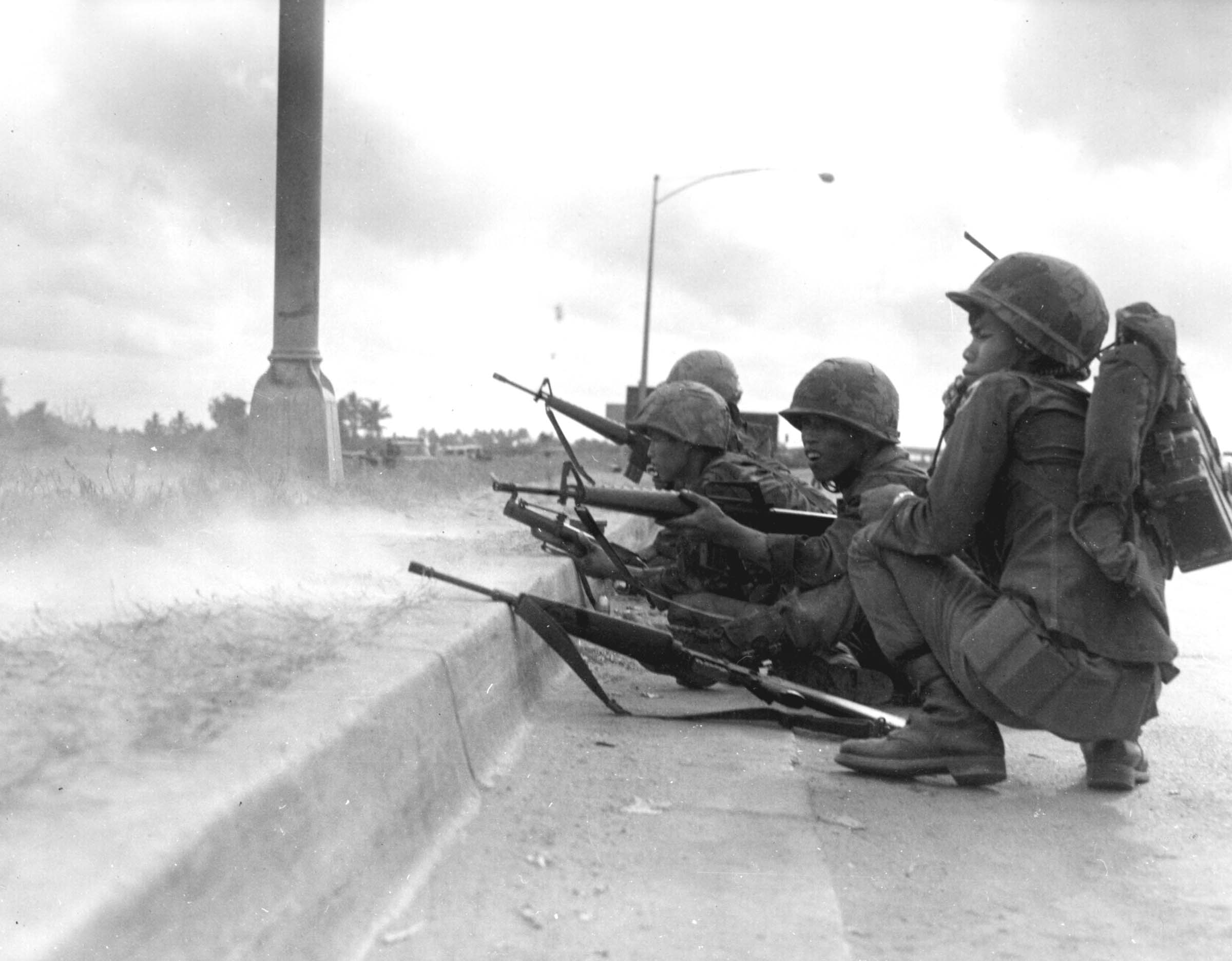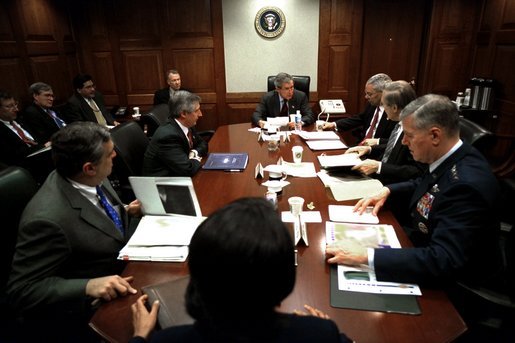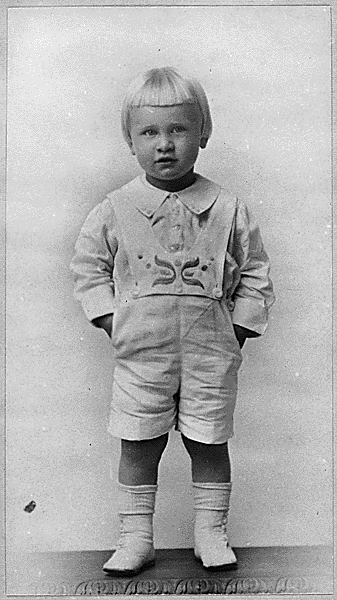|
Operation Frequent Wind
Operation Frequent Wind was the final phase in the evacuation of American civilians and "at-risk" Vietnamese from Saigon, South Vietnam, before the takeover of the city by the North Vietnamese People's Army of Vietnam (PAVN) in the Fall of Saigon. It was carried out on 29–30 April 1975, during the last days of the Vietnam War. More than 7,000 people were evacuated by helicopter from various points in Saigon. The airlift resulted in a number of enduring images. Evacuation plans already existed as a standard procedure for American embassies. At the beginning of March, fixed-wing aircraft began evacuating civilians from Tan Son Nhat Airport through neighboring countries. By mid-April, contingency plans were in place and preparations were underway for a possible helicopter evacuation. As the imminent collapse of Saigon became evident, the U.S. Navy assembled Task Force 76 off the coast near Vũng Tàu to support a helicopter evacuation and provide air support if required. In the ... [...More Info...] [...Related Items...] OR: [Wikipedia] [Google] [Baidu] |
Fall Of Saigon
The Fall of Saigon, also known as the Liberation of Saigon by North Vietnamese or Liberation of the South by the Vietnamese government, and known as Black April by anti-communist overseas Vietnamese was the capture of Ho Chi Minh City, Saigon, the capital of South Vietnam, by the People's Army of Vietnam (PAVN) and the Viet Cong, National Liberation Front of South Vietnam (Viet Cong) on April 1975, 30 April 1975. The event marked the end of the Vietnam War and the start of a transition period from the formal reunification of Vietnam into the Socialist Republic of Vietnam. The PAVN, under the command of General Văn Tiến Dũng, began their final attack on Saigon on 29 April 1975, with the Army of the Republic of Vietnam (ARVN) forces commanded by General Nguyễn Văn Toàn (general), Nguyễn Văn Toàn suffering a heavy artillery bombardment. By the afternoon of the next day, the PAVN and the Viet Cong had occupied the important points of the city and raised their flag over th ... [...More Info...] [...Related Items...] OR: [Wikipedia] [Google] [Baidu] |
Defense Attaché Office, Saigon (1973–1975)
The Defense Attaché Office, Saigon (also known as DAO, Saigon or simply DAO) was a joint-service command and military attaché branch of the United States Department of Defense (DOD) under the control of United States Support Activities Group (USSAG). It assumed all DOD responsibilities in South Vietnam following the disestablishment of Military Assistance Command, Vietnam (MACV) in March 1973. The DAO was responsible for administering military assistance and support to the South Vietnamese armed forces, the gathering and distribution of military intelligence and the performance of normal Defense Attaché functions. The DAO remained in existence until August 1975. Background and structure Under the terms of the Paris Peace Accords MACV and all American and third country forces had to be withdrawn from South Vietnam within 60 days of the ceasefire. A small U.S. military headquarters was needed to continue the military assistance program for the South Vietnamese military and su ... [...More Info...] [...Related Items...] OR: [Wikipedia] [Google] [Baidu] |
Tan Son Nhut
Tân Sơn Nhất International Airport ( vi, Sân bay quốc tế Tân Sơn Nhất or Cảng hàng không quốc tế Tân Sơn Nhất) is the busiest airport in Vietnam with 32.5 million passengers in 2016 and 38.5 million passengers in 2018. It serves Ho Chi Minh City as well as the rest of southeastern Vietnam. As of January 2017, it had a total capacity of only 25 million passengers, which has caused constant congestion and sparked debate for expanding or building a new airport. The airport's IATA code, SGN, is derived from the city's former name of ''Saigon''. It was the 25th busiest airport in the world in 2020. Of the routes the airport offers, the domestic Ho Chi Minh City – Hanoi route is the busiest in Southeast Asia and the sixth busiest in the world, serving 10,253,530 customers in 2019. History Tan Son Nhat International Airport has its origins in the early 1930s when the French colonial government constructed a small airport with unpaved runways, known as ... [...More Info...] [...Related Items...] OR: [Wikipedia] [Google] [Baidu] |
Army Of The Republic Of Vietnam
The Army of the Republic of Vietnam (ARVN; ; french: Armée de la république du Viêt Nam) composed the ground forces of the South Vietnamese military from its inception in 1955 to the Fall of Saigon in April 1975. It is estimated to have suffered 1,394,000 casualties (killed and wounded) during the Vietnam War. The ARVN began as a postcolonial army that was trained by and closely affiliated with the United States and had engaged in conflict since its inception. Several changes occurred throughout its lifetime, initially from a 'blocking-force' to a more modern conventional force using helicopter deployment in combat. During the American intervention, the ARVN was reduced to playing a defensive role with an incomplete modernisation, and transformed again following Vietnamization, it was upgeared, expanded, and reconstructed to fulfill the role of the departing American forces. By 1974, it had become much more effective with foremost counterinsurgency expert and Nixon advi ... [...More Info...] [...Related Items...] OR: [Wikipedia] [Google] [Baidu] |
1975 Spring Offensive
The 1975 spring offensive ( vi, chiến dịch mùa Xuân 1975), officially known as the general offensive and uprising of spring 1975 ( vi, Tổng tiến công và nổi dậy mùa Xuân 1975) was the final North Vietnamese campaign in the Vietnam War that led to the capitulation of Republic of Vietnam. After the initial success capturing Phước Long Province, the North Vietnamese leadership increased the scope of the People's Army of Vietnam's (PAVN) offensive and captured and held the key Central Highlands city of Buôn Ma Thuột between 10 and 18 March. These operations were intended to be preparatory to launching a general offensive in 1976. Following the attack on Buôn Ma Thuôt, the Republic of Vietnam realized they were no longer able to defend the entire country and ordered a strategic withdrawal from the Central Highlands. The retreat from the Central Highlands, however, was a debacle as civilian refugees fled under fire with soldiers, mostly along a single h ... [...More Info...] [...Related Items...] OR: [Wikipedia] [Google] [Baidu] |
William Colby
William Egan Colby (January 4, 1920 – May 6, 1996) was an American intelligence officer who served as Director of Central Intelligence (DCI) from September 1973 to January 1976. During World War II Colby served with the Office of Strategic Services. After the war he joined the newly created Central Intelligence Agency (CIA). Before and during the Vietnam War, Colby served as chief of station in Saigon, chief of the CIA's Far East Division, and head of the Civil Operations and Rural Development effort, as well as overseeing the Phoenix Program. After Vietnam, Colby became director of central intelligence and during his tenure, under intense pressure from the Congress and the media, adopted a policy of relative openness about U.S. intelligence activities to the Senate Church Committee and House Pike Committee. Colby served as DCI under President Richard Nixon and President Gerald Ford until January 30, 1976; he was succeeded at the CIA by George H. W. Bush. Early life an ... [...More Info...] [...Related Items...] OR: [Wikipedia] [Google] [Baidu] |
International Commission Of Control And Supervision
The International Commission of Control and Supervision (ICCS) was an international monitoring force created on 27 January 1973. It was formed, following the signing of the Paris Peace Accords ("Paris Agreement on Ending the War and Restoring Peace in Vietnam"), to replace the similarly-named International Commission for Supervision and Control in Vietnam (ICSC). Personnel The organization comprised military and civilian staffs, provided by four nations. Initially, these were: Canada, Hungary, Indonesia and Poland ('CHIP'). The Canadian and Polish delegations had been present for nearly two decades, whilst the Hungarians and Indonesians were new to the task. For balance, the countries were expressly chosen to represent both the communist nations, Poland and Hungary, and the non-communist nations, Canada and Indonesia. Canada had previously expressed dissatisfaction, and stayed largely to endure the successful establishment of the new body: it was a member from 29 January until 31 ... [...More Info...] [...Related Items...] OR: [Wikipedia] [Google] [Baidu] |
Henry Kissinger
Henry Alfred Kissinger (; ; born Heinz Alfred Kissinger, May 27, 1923) is a German-born American politician, diplomat, and geopolitical consultant who served as United States Secretary of State and National Security Advisor under the presidential administrations of Richard Nixon and Gerald Ford. A Jewish refugee who fled Nazi Germany with his family in 1938, Kissinger excelled academically, receiving his BA degree '' summa cum laude'' from Harvard College in 1950, studying under William Yandell Elliott. He received his MA and PhD degrees at Harvard University in 1951 and 1954, respectively. For his actions negotiating a ceasefire in Vietnam, Kissinger received the 1973 Nobel Peace Prize under controversial circumstances. A practitioner of ''Realpolitik'', Kissinger played a prominent role in United States foreign policy between 1969 and 1977, pioneering the policy of détente with the Soviet Union, orchestrating an opening of relations with the People's Republic o ... [...More Info...] [...Related Items...] OR: [Wikipedia] [Google] [Baidu] |
United States National Security Council
The United States National Security Council (NSC) is the principal forum used by the President of the United States for consideration of national security, military, and foreign policy matters. Based in the White House, it is part of the Executive Office of the President of the United States, and composed of senior national security advisors and Cabinet officials. Since its inception in 1947 by President Harry S. Truman, the function of the Council has been to advise and assist the President on national security and foreign policies. It also serves as the President's principal arm for coordinating these policies among various government agencies. The Council has subsequently played a key role in most major events in U.S. foreign policy, from the Korean War to the War on Terror. The NSC has counterparts in the national security councils of many other nations. History The immediate predecessor to the National Security Council was the National Intelligence Authority (NI ... [...More Info...] [...Related Items...] OR: [Wikipedia] [Google] [Baidu] |
Gerald Ford
Gerald Rudolph Ford Jr. ( ; born Leslie Lynch King Jr.; July 14, 1913December 26, 2006) was an American politician who served as the 38th president of the United States from 1974 to 1977. He was the only president never to have been elected to the office of president or vice president as well as the only president to date from Michigan. He previously served as the leader of the Republican Party in the House of Representatives, and was appointed to be the 40th vice president in 1973. When President Richard Nixon resigned in 1974, Ford succeeded to the presidency, but was defeated for election to a full term in 1976. Born in Omaha, Nebraska, and raised in Grand Rapids, Michigan, Ford attended the University of Michigan, where he was a member of the school's football team, winning two national championships. Following his senior year, he turned down offers from the Detroit Lions and Green Bay Packers, instead opting to go to Yale Law School. After the attack on Pearl Ha ... [...More Info...] [...Related Items...] OR: [Wikipedia] [Google] [Baidu] |
NSC Meeting, April 9, 1975 (topic- Vietnam, Cambodia)(Gerald Ford Library)(1552383)
NSC may refer to: Sport and competition * NSC United, an American soccer team * National Scholastics Championship, an American quiz bowl competition * National Scrabble Championship, now known as the Scrabble Players Championship * National Shooting Centre, historic British shooting sports complex near Bisley, United Kingdom * National Sports Center, an American sports complex * National Sports Centre (Isle of Man) * National Sports Club of India *Nejmeh SC, a Lebanese association football club * Nepean Sailing Club * North Star Conference, a women's college sports conference Education * National Senior Certificate, a South African educational certificate * Nehru Science Centre, Mumbai, India * Nevada State College * Northern Southland College, a secondary School in Lumsden, New Zealand * Yoshimoto New Star Creation, a Japanese comedy school Transport * National Security Cutter, a U.S. Coast Guard ship design * Network SouthCentral, a British railway company * Norfolk S ... [...More Info...] [...Related Items...] OR: [Wikipedia] [Google] [Baidu] |
Grumman F-14 Tomcat
The Grumman F-14 Tomcat is an American carrier-capable supersonic, twin-engine, two-seat, twin-tail, variable-sweep wing fighter aircraft. The Tomcat was developed for the United States Navy's Naval Fighter Experimental (VFX) program after the collapse of the General Dynamics-Grumman F-111B project. The F-14 was the first of the American Teen Series fighters, which were designed incorporating air combat experience against MiG fighters during the Vietnam War. The F-14 first flew on 21 December 1970 and made its first deployment in 1974 with the U.S. Navy aboard , replacing the McDonnell Douglas F-4 Phantom II. The F-14 served as the U.S. Navy's primary maritime air superiority fighter, fleet defense interceptor, and tactical aerial reconnaissance platform into the 2000s. The Low Altitude Navigation and Targeting Infrared for Night ( LANTIRN) pod system was added in the 1990s and the Tomcat began performing precision ground-attack missions. The Tomcat was retired by U.S. Navy ... [...More Info...] [...Related Items...] OR: [Wikipedia] [Google] [Baidu] |







.jpg)


